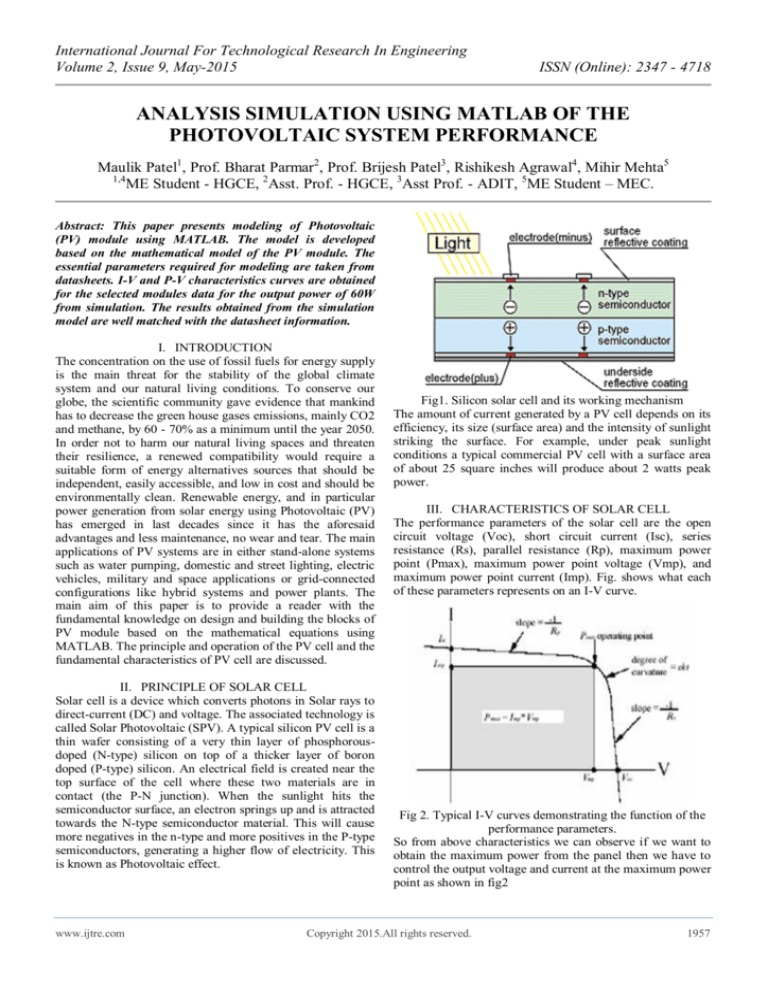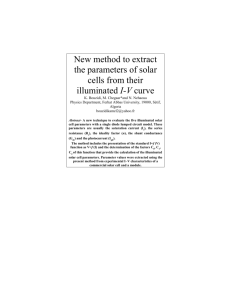
International Journal For Technological Research In Engineering
Volume 2, Issue 9, May-2015
ISSN (Online): 2347 - 4718
ANALYSIS SIMULATION USING MATLAB OF THE
PHOTOVOLTAIC SYSTEM PERFORMANCE
Maulik Patel1, Prof. Bharat Parmar2, Prof. Brijesh Patel3, Rishikesh Agrawal4, Mihir Mehta5
1,4
ME Student - HGCE, 2Asst. Prof. - HGCE, 3Asst Prof. - ADIT, 5ME Student – MEC.
Abstract: This paper presents modeling of Photovoltaic
(PV) module using MATLAB. The model is developed
based on the mathematical model of the PV module. The
essential parameters required for modeling are taken from
datasheets. I-V and P-V characteristics curves are obtained
for the selected modules data for the output power of 60W
from simulation. The results obtained from the simulation
model are well matched with the datasheet information.
I. INTRODUCTION
The concentration on the use of fossil fuels for energy supply
is the main threat for the stability of the global climate
system and our natural living conditions. To conserve our
globe, the scientific community gave evidence that mankind
has to decrease the green house gases emissions, mainly CO2
and methane, by 60 - 70% as a minimum until the year 2050.
In order not to harm our natural living spaces and threaten
their resilience, a renewed compatibility would require a
suitable form of energy alternatives sources that should be
independent, easily accessible, and low in cost and should be
environmentally clean. Renewable energy, and in particular
power generation from solar energy using Photovoltaic (PV)
has emerged in last decades since it has the aforesaid
advantages and less maintenance, no wear and tear. The main
applications of PV systems are in either stand-alone systems
such as water pumping, domestic and street lighting, electric
vehicles, military and space applications or grid-connected
configurations like hybrid systems and power plants. The
main aim of this paper is to provide a reader with the
fundamental knowledge on design and building the blocks of
PV module based on the mathematical equations using
MATLAB. The principle and operation of the PV cell and the
fundamental characteristics of PV cell are discussed.
II. PRINCIPLE OF SOLAR CELL
Solar cell is a device which converts photons in Solar rays to
direct-current (DC) and voltage. The associated technology is
called Solar Photovoltaic (SPV). A typical silicon PV cell is a
thin wafer consisting of a very thin layer of phosphorousdoped (N-type) silicon on top of a thicker layer of boron
doped (P-type) silicon. An electrical field is created near the
top surface of the cell where these two materials are in
contact (the P-N junction). When the sunlight hits the
semiconductor surface, an electron springs up and is attracted
towards the N-type semiconductor material. This will cause
more negatives in the n-type and more positives in the P-type
semiconductors, generating a higher flow of electricity. This
is known as Photovoltaic effect.
www.ijtre.com
Fig1. Silicon solar cell and its working mechanism
The amount of current generated by a PV cell depends on its
efficiency, its size (surface area) and the intensity of sunlight
striking the surface. For example, under peak sunlight
conditions a typical commercial PV cell with a surface area
of about 25 square inches will produce about 2 watts peak
power.
III. CHARACTERISTICS OF SOLAR CELL
The performance parameters of the solar cell are the open
circuit voltage (Voc), short circuit current (Isc), series
resistance (Rs), parallel resistance (Rp), maximum power
point (Pmax), maximum power point voltage (Vmp), and
maximum power point current (Imp). Fig. shows what each
of these parameters represents on an I-V curve.
Fig 2. Typical I-V curves demonstrating the function of the
performance parameters.
So from above characteristics we can observe if we want to
obtain the maximum power from the panel then we have to
control the output voltage and current at the maximum power
point as shown in fig2
Copyright 2015.All rights reserved.
1957
International Journal For Technological Research In Engineering
Volume 2, Issue 9, May-2015
ISSN (Online): 2347 - 4718
Short Circuit Current (ISC) – This is the maximum current
that the cell can provide and it occurs when the cells is shortcircuited. Unlike other small scale electricity generating
systems PV cells are not harmed by being shorted out.
Open circuit Current (VOC) – This is the maximum voltage
that exists between the cells terminals and is obtained when
there is no load connected across them .
Maximum Power Point (PMax) – This is the point on the I-V
curve at which maximum power is being produced by the
cell. Note that since the graph is not a straight line, the power
produced will vary depending on the operating voltage;
although the voltage at any point on the graph can still be
calculated using P=IV. PMax occurs on the 'knee' of the I-V
curve.
IV. BASIC EQUIVALENT CIRCUIT OF SOLAR CELL
The complex physics of the PV cell can be represented by the
equivalent electrical circuit Fig4.1. The most common
approach to solar cell modeling is the use of single diode
solar cell equivalent circuit
Fig 3.Basic equivalent circuit of solar cell.
The complex physics of the PV cell can be represented by the
equivalent electrical circuit (Fig.3.). The most common
approach to solar cell modeling is the use of single diode
solar cell equivalent circuit. The cell structure and parameters
involve photocurrent, diode reverse saturation current, diode
ideality factor, series resistance and shunt resistance, which
need to be identified for every operating condition for the
accurate modeling of solar cell behavior.
V. MATLAB SIMULATION OF PROPOSED SYSTEM
solar cell parameter for simulation
Short circuit current Isc= 4.75 I
Open circuit voltage Voc= 0.6 V
Irradiance used for measurements Iro= 1000 W/𝑚2
Quality factor N= 1.6
Series resistance RS= 5.1e-3 ohm
Show in figure I have used some parameter like a constant,
Simulink-PS converter, solar cell, current sensor, voltage
sensor, resistor, PS-Simulink converter, Solver configuration,
product, scope, Electrical reference. Here in simulation I
used a 18 solar cell connected in series.
www.ijtre.com
Fig. 4. Matlab simulation of proposed system
VI. SIMULATION RESULT
Solar radiation S= 1000
Fig 5. Result of Proposed systemI=4.6 Amp & V=4.9 volt&
P=22.5 watt
Solar radiation S=1000
Fig 6. Result of Proposed system So result is I=4.4 Amp&
V=8.5 Volt& P=37.4watt
Copyright 2015.All rights reserved.
1958
International Journal For Technological Research In Engineering
Volume 2, Issue 9, May-2015
ISSN (Online): 2347 - 4718
Solar radiation S= 1000
Solar radiation S= 600w/m2, P-V and I-V Curve
Fig 7. Result of Proposed system I=3.3 Amp& V=9.5 Volt&
P=31.35 Watt
Detail Solar P V simulation to obtain P-V and I-V curve
Fig 8. Solar PV simulation to obtain P-V and I-V curve
Solar radiation S= 400w/m2, P-V and I-V Curve
www.ijtre.com
Simulation result with temperature effect on PV Array
Performance.
Solar radiation S= 1000w/m2, Cell Temperature T= 15’C,
P-V and I-V Curve
Copyright 2015.All rights reserved.
1959
International Journal For Technological Research In Engineering
Volume 2, Issue 9, May-2015
ISSN (Online): 2347 - 4718
With increase in the solar radiation the open circuit voltage
increases. This model can be used for the analysis in the field
of solar photovoltaic system and MPPT technologies and
new topology block diagram for implementation of PV
system with grid as a backup with we can provide maximum
reliability of supply to load or consumer.
Solar radiation S= 1000w/m2, Cell Temperature T= 25’C, PV and I-V Curve
VII. CONCLUSION
The proposed model of PV module takes solar radiation
intensity and cell temperature as input and outputs current
and voltage characteristics under various conditions. We
conclude that the insolation change affects more to the
photon generated current and has very little effect on the
open circuit voltage and also measure the effect of variation
in temperature that if the temperature increases the solar cell
efficiency is reduced. As we increase the solar radiation,
higher would be the solar input to the solar cell and hence
power magnitude would increase for the same voltage value.
www.ijtre.com
REFERENCES
[1] Mohammed Khorshed Alam “Optimization of sub
cell interconnection for multi junction solar cells
using switching power converters” IEEE
TRANSACTIONS ON SUSTAINABLE ENERGY,
VOL.4,NO.2, APRIL.2013
[2] Weidong Xiao “A Modified Adaptive Hill Climbing
MPPT Method for Photovoltaic Power Systems”
2005 35th Annual IEEE Power Electronics
Specialists Conference
[3] Patrick M. Corrigan “Optimized Dispatch of a
Residential Solar Energy System” 978-1-42441726-1/07/$25.00_c 2007 IEEE
[4] Dr. LipingGuo “Design and Simulation of a Sun
Tracking solar power” 120th ASEE Annual
Conference & Exposition June 23-36, 2013
[5] PrakornchaiPhonrattanasak “Optimal Location and
Sizing of Solar Farm on Japan East Power System
Using Multi objective Bees Algorithm”
[6] M. Irwanto “Analysis Simulation of the
Photovoltaic Output Performance” 2014 IEEE 8th
International Power Engineering and Optimization
Conference (PEOCO2014), Langkawi, The Jewel of
Kedah, Malaysia. 24-25 March 2014
[7] XuXiaoli “Research of Power Optimizing
Technique for Solar Photovoltaic System” 2010
International Conference on Optoelectronics and
Image Processing
[8] Maricar, N. M., Lee, E., Lim, H. K., Sepikit, M. F.,
Maskum, M. R. M.,Ahmad, “PV Solar Energy
Technology Overview for Malaysia Senario”,Power
Engineering Conference, pp.300-305, 2003.
[9] John A. Duffie& William A. Beckman, “Solar
Engineering of Thermal Process”, 3rd ed,John
Wiley & Sons, pp. 747-773, (2006).
[10] SavitaNema, R.K. Nema, GayatriAgnihotri,
“MATLAB/Simulink based study of photovoltaic
cells / modules / array and their experimental
verification”, International journal of Energy and
Environment, vol.1, No.3, pp.487-500, 2010.
[11] Krishan, R.; Sood, Y.R.; Uday Kumar, B., "The
simulation and design for analysis of photovoltaic
system based on MATLAB," Energy Efficient
Technologies for Sustainability (ICEETS), 2013
International Conference on, vol., no., pp.647, 651,
10-12 April 2013.
[12] Altas, I.H.; Sharaf, A.M., "A Photovoltaic Array
Simulation Model for Matlab-Simulink GUI
Environment," Clean Electrical Power, 2007.
ICCEP '07. International Conference on, vol., no.
pp.341, 345, 21-23 May 2007.
Copyright 2015.All rights reserved.
1960
International Journal For Technological Research In Engineering
Volume 2, Issue 9, May-2015
ISSN (Online): 2347 - 4718
[13] Bhuvaneswari, G.;Annamalai, R., "Development of
a solar cell model in MATLAB for PV based
generation system," India Conference (INDICON),
2011 Annual IEEE, vol., no., pp.1,5, 16-18 Dec.
2011.
www.ijtre.com
Copyright 2015.All rights reserved.
1961







